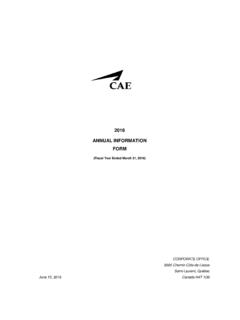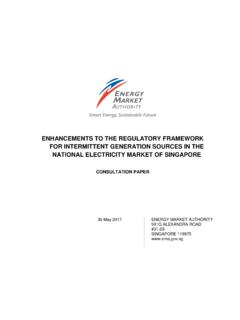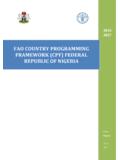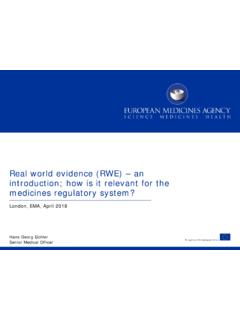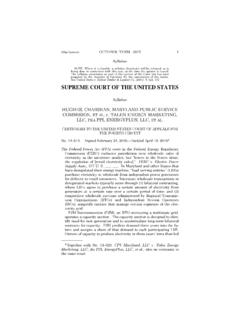Transcription of Airline Pilot Demand Outlook - CAE Inc.
1 Airline Pilot Demand Outlook 10-year view Yourworldwide Your worldwide trainingpartner training partner ofchoice of choice Airline Pilot Demand , 10-year Outlook at a glance Dear aviation colleagues, City-pairs Active Passenger trips with direct ights commercial aircraft As you may know, the projected increase in passenger air traffic is expected to double the size of the commercial aviation industry over the next 20 years. This growth has significant 25k 37K implications for the professional Pilot pipeline worldwide. +12K 150k +1,6B 18k +7K 25K As the industry's training partner of choice, we work with over 300 airlines and train more than 120,000 pilots annually at every phase of their career. These relationships give us Growth of active a privileged vantage point of both the market and industry Pilot pool needs. 2017 2027 2017 2027 2017 2027 On behalf of CAE, I am proud to share these insights with the broader industry for the first time through our Airline Pilot Demand Outlook .
2 This 10-year view builds on a detailed forecast and addresses Airline Pilot needs globally. Pilot age in 2016. Our analysis identifies a global requirement for 255,000 new A maturing Pilot population <35 105k Airline pilots over the next 10 years to sustain and grow the commercial air transport industry. Rapid fleet expansion and 35-49. high Pilot retirement rates create a further need to develop 180,000 first officers into new Airline captains, more than in Mandatory retirement age is 65 any previous decade. >50 pilots retiring or exiting the workforce These numbers mean that over 50% of the pilots who will fly the world's commercial aircraft in 10 years have not yet started to train. This record Demand will challenge current Pilot recruitment channels and development programs. In turn, new and innovative Pilot career pathways and training systems will be required to meet the industry's crewing needs and ever-evolving safety standards. 255k 2017. 2027.
3 2017. 2027. At CAE, we look forward to shaping the future of Pilot training with you. Together let's ensure that our industry has the 2017. 2027. MIDDLE EAST. qualified pilots it requires to continue leading the way in 2017. 2027. AMERICAS EUROPE & AFRICA ASIA-PACIFIC New pilots required safety and security cost effectively and efficiently. +85K +50K +30K +90K for growth and replacement New pilots New pilots New pilots New pilots Nick Leontidis CAE Group President Civil Aviation Training Solutions 50%. Of pilots ying by 2027 have 70. New pilots /day 180k New captains not started to train yet CAE Airline Pilot Demand Outlook : 10-YEAR VIEW |3. 07 Part I: Current Airline Pilot landscape 08 Where today's Airline pilots come from 10 Pilot training progression Table 13. 14. Part II: Drivers of Airline Pilot Demand Fleet growth of contents 16 Pilot /aircraft ratios 18 Pilot retirement and attrition 21 Part III: 10-year forecast 22 Summary 23 A look at the four regions 24 Americas 26 Europe 28 Middle East and Africa 30 Asia-Pacific 33 Part IV: Moving forward 34 Filling tomorrow's cockpits 36 Developing tomorrow's Airline pilots CAE Airline Pilot Demand Outlook : 10-YEAR VIEW |5.
4 Current Airline Part I Pilot landscape The CAE Airline Pilot Demand Outlook doesn't consider major disruptions to key drivers, such as regulatory changes in retirement age or global health pandemics. Our analysis is based on the steady evolution of the environment surround- ing these drivers, including new aircraft designs. CAE Airline Pilot Demand Outlook : 10-YEAR VIEW |7. Where today's Today, almost 10% of Airline pilots in Asia- Airline pilots come from Pacific are expatriates. In 2016, approximately 20,000 pilots airlines in regions of rapid growth face limited access to experienced pilots in their entered the Airline profession around markets. To address this challenge, they focus on accelerating the development of the world from three main sources. junior first officers, a lengthy process, and on hiring experienced first officers and captains from more mature markets. Airline -focused flight training academies Some 6,500 pilots hired in 2016 were trained Pilot supply* Almost 10% of Airline pilots today in Asia at professional academies that work directly Pacific are expatriates.
5 In some instances, with airlines to identify and meet their re- airlines in the Middle East source over half cruitment needs. These academies focus on 11K of their pilots from outside their region. creating professional pilots and, in general, over 90% of their graduates become Airline Compensation is a key tool used by airlines pilots . to attract experienced pilots . Middle Eastern and Asia-Pacific carriers offer, on average, a Universities, military & business aviation 10% to 15% salary premium to their pilots compared to carriers in the western hemi- Approximately 3,000 pilots came from mili- sphere. airlines in China sometimes offer tary, business jet or university backgrounds. salary premiums in excess of 70%. Combined Some universities offer undergraduate pro- with advantages such a tax relief, many grams in combination with commercial Pilot 4K 4K. fast growing markets continue to attract training. However, a small portion of these 3K experienced pilots .
6 Individuals pursues a career as Airline pilots . Small regional flight clubs & schools Some 10,500 pilots came from smaller in- 2016 average narrow-body dependent training organizations generally Pilot salary*. located at smaller airports and serving both 2012 2016 2012 2016 2012 2016. recreational and commercial pilots . Less than +12% +14%. 70% of these trainees become Airline pilots . Airline -focused flight training academies * Based on CAE analysis produce an increasing proportion of the pilots flying in today's commercial airlines . These professional academies provide an environment with set schedules, access airlines are more actively involved in to pilots , mentoring, mandatory uniforms and an Airline mindset. When enrolled in ensuring cadets are trained to their programs built to Airline -specific operating procedures, cadets train to a professional professional standard from day one. standard from day one. Western Asia-Paci c Middle East hemisphere * Based on CAE analysis 8 | CAE Airline Pilot Demand Outlook : 10-YEAR VIEW CAE Airline Pilot Demand Outlook : 10-YEAR VIEW |9.
7 Pilot training progression The continuous evolution of Pilot training However, over the past two decades, regu- regulations has contributed to the air trans- lated training has increasingly leveraged the port industry's safety record. Over the past use of data and competencies to improve Added data few decades, the industry has consistently training outcomes. beyond flight envelope improved Pilot training to further enhance safety. Former regulatory requirements empha- sized highly structured and rigid training Extended addressability programs to ensure global compliance and of data and competency- standardization. driven systems Combined competencies and training data Integrated Pilot competencies framework Complemented with MPL EBT UPRT. structure for line data The advent of the Multi-Crew Pilot Evidence-Based Training (EBT), a joint Upset Prevention and Recovery Train- Incorporated line Licence (MPL) is a key milestone that effort between ICAO, IATA and IFALPA ing (UPRT) uses competencies and data flying observations marked the industry coming together (International Federation of Air Line from inside and outside the regular to improve the Pilot creation process.)
8 pilots ' Associations), incorporates op- flight envelope. erational data (flight data analysis, flight MPL leveraged ICAO's competency observations and air safety reports) It addresses the number one cause of AQP/ATQP FOQA ICAO Pilot competencies framework and introduced an objec- into Pilot training and assessment to accidents leading to fatalities by focusing tive development process for cadets. improve air safety. on the competencies related to situ- The FAA introduced the Advanced Supported by ICAO, Flight Operations The International Civil Aviation Organi- ational awareness and manual flying. Qualification Program (AQP) as an Quality Assurance (FOQA), also known zation (ICAO) developed a framework MPL further leverages the increased use This helps develop and assess the overall alternate means for complying with as Flight Data Monitoring (FDM), brought of eight competencies covering the of simulation based training by having capability for training across the range UPRT training is now required by EASA.
9 Existing rigid regulated training. The in a structured approach to collecting knowledge, skills and attitude required cadets spend over half of their practical of competencies. and will be required by the FAA for all European equivalent, the Alternative line flying data. to fly in a commercial environment. training in a commercial aircraft cockpit FAR 121 operators by 2019, alongside Training and Qualification Program as opposed to a small private aircraft. EBT provides a baseline, ready-made full stall and adverse conditions training (ATQP), was introduced later under Recurrent AQP/ATQP programs ben- This elevated the importance of leader- training program that allows smaller (bounced landing, icing and crosswinds EASA. efited from FOQA by leveraging line-data ship, communication, situational aware- These ab-initio programs provide an operators to adopt data-driven, com- on takeoff). analysis to improve training outcomes. ness and decision making by providing a effective way to train high-quality pilots petency-based training.
10 AQP and ATQP allowed the industry framework to develop and assess pilots . in a line-flying environment. The first to leverage line-flying experience to The majority of airlines training under MPL graduates are now successful inform and improve training. AQP programs today have FOQA and captains. data analysis capabilities. Regulated training increasingly airlines were now able to modify their training programs to address their leverages the use of data and unique operational requirements. competencies to improve Today, over 80% of Airline pilots in the US are training under an AQP. training outcomes. 10 | CAE Airline Pilot Demand Outlook : 10-YEAR VIEW CAE Airline Pilot Demand Outlook : 10-YEAR VIEW | 11. Drivers of Airline Part II Pilot Demand Pilot Demand is driven by the overall Demand for commercial flights, how these flights are crewed and the need to replace pilots exiting the workforce. CAE Airline Pilot Demand Outlook : 10-YEAR VIEW | 13. Fleet growth 2016 saw ongoing growth in global air passenger traffic and a corresponding increase in the number of commercial aircraft operated by airlines .
